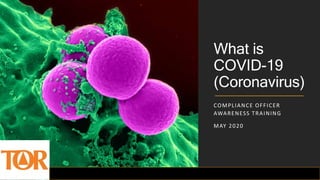
What is covid 19
- 1. What is COVID-19 (Coronavirus) COMPLIANCE OFFICER AWARENESS TRAINING MAY 2020
- 2. What is COVID-19? (Coronavirus) Coronavirus disease (COVID-19) is an infectious disease previously not identified in humans
- 3. Most people infected with the COVID-19 virus will experience mild to moderate respiratory illness and recover without requiring special treatment. Older people, and those with underlying medical problems like cardiovascular disease, diabetes, chronic respiratory disease, and cancer are more likely to develop serious illness. The best way to prevent transmission is be well informed about the COVID-19 virus, the disease it causes and how it spreads. Protect yourself and others from infection by washing your hands or using an alcohol based rub frequently and not touching your face.
- 4. The COVID-19 virus spreads primarily through droplets of saliva or discharge from the nose when an infected person coughs or sneezes, so it’s important that you also practice respiratory etiquette (for example, by coughing into a flexed elbow). At this time, there are no specific vaccines or treatments for COVID-19. However, there are many ongoing clinical trials evaluating potential treatments. The World Health Organisation (WHO) continue to provide updated information as soon as clinical findings become available.
- 5. How does COVID-19 spread? It can be spread from person to person. In ways that are very similar to passing on a common cold or the flu.
- 6. The most common spread is from droplets produced when someone who is infected coughs or sneezes. If someone is close to this person they are at risk of contracting the virus from the droplets by breathing them in through nose mouth or absorbing via eyes. There is also a risk of contamination by infected people touching or coming into contact with objects they touch and transferring the virus to these objects, when someone else touches the object they then pick up the virus.
- 7. Signs & Symptoms of COVID- 19 The time between exposure to COVID-19 and the moment when symptoms start is commonly around five to six days but can range from 1 – 14 days.
- 8. The most common symptoms of COVID-19 are fever, tiredness, and dry cough. Some people may have aches and pains, nasal congestion, runny nose, sore throat or diarrhoea. These symptoms are usually mild and begin gradually. Some people become infected but don’t develop any symptoms and don't feel unwell. The virus seems to start with a fever, followed by a dry cough and then, after a week, leads to shortness of breath and some patients needing hospital treatment.
- 9. Congratulations You have completed this module. Now return to the Course menu to take quiz about ‘What is COVID-19’